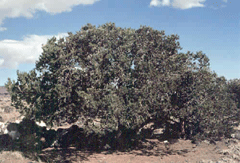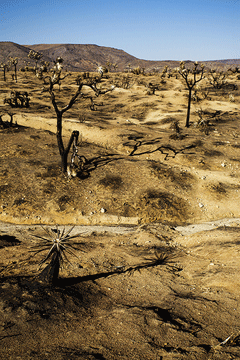Under An Arizona Sun
Air Date: Week of February 23, 2007

Juniper has taken over where piñon once stood. Drought, bark beetles and a warming climate have killed thousands of piñons in Northern Arizona. (Photo: Sadie Babits)
Sadie Babits reports from Northern Arizona on the changes that global warming is bringing to the region. Researchers are examining the past and the present to get an idea of what the future holds for a warmer, and probably drier, Arizona.
Transcript
CURWOOD: Scientists at the National Center for Atmospheric Research tell us that the western part of the United States is feeling the effects of climate change more than the East right now. And certainly one part of the West where changes are becoming more tangible is the state of Arizona. As Sadie Babits reports researchers are looking at the region’s archeological past to help understand the new present and the likely future.
BABITS: Ken Cole’s eyes twinkle when he talks about ancient trash heaps. He’s a research ecologist and he studies “middens” – centuries old stashes left behind by… desert pack rats. Cole holds one in his hand that’s more than two thousand years old.
COLE: This fossil here is from Whitmore Wash. This is a place 100 km up river from Lake Mead and this is one of the ways that we’re studying how plants react to climate change.
BABITS: This midden is a treasure trove of desert ecology, a nest of seeds, twigs, leaves even feces all glued together by viscous thousand year old rat urine.
COLE: If this is under a ledge that doesn’t get any rainfall falling on it, then it’s just gonna stay there forever – and the plant bits are not gonna decompose because while they’re incased in this rat urine. They’re essentially mummified.
BABITS: Cole carbon dates his samples here at the USGS Southwest Biological Science Center in Flagstaff. Some of the middens date back to the end of the last glacial period. Scientists know that at that time, plants and animals were on the move.
COLE: If you get the climate warming suddenly like it did 11,600 years ago, plants will adjust very rapidly when moving up hill, say to a mountain top, but more slowly when moving northward a long distance.
BABITS: During that last warming period, the junipers, the scrubby plant down in the Grand Canyon, died off. Young juniper plants migrated up to the rim of the canyon in search of the cooler temperatures they favor. Researchers observe something similar happening today in Northern Arizona.

Juniper has taken over where piñon once stood. Drought, bark beetles and a warming climate have killed thousands of piñons in Northern Arizona.
(Photo: Sadie Babits)
[DRIVING SOUNDS]
Biologist Neil Cobb drives his Toyota truck up a snow covered mountain road. Cobb loves this land, this living laboratory. He leads the Merriam-Powell Center for Environmental Research in Flagstaff. As part of his work, he’s been cataloguing dead pinion pines up here. It’s earned him the nickname Dr. Death.
COBB: I came here in 1985, um you’d be very hard pressed to find a dead piñon or juniper anywhere. And then 2002 hit and we just had spectacular mortality with piñon.
BABITS: In 2002, Arizona was six years into a severe drought that continues today. Then Bark beetles multiplied in the drought-stressed trees, finishing the piñons off.
[CAR DOOR SLAM]
COBB: Hi dorks.
[WALKING IN SNOW]
BABITS: Today what was a closed woodland has turned to open scrubby juniper.
COBB: And you can see, we’re actually walking through it now so almost every live tree you see are junipers. All the carcasses are piñons. It used to be a more 50/50 or 60 % pinion 40 % juniper and now it’s almost, pretty much 100% juniper.

The piñon pine is the most drought-resistant of all the pines in Arizona. (Courtesy of Arizona Game and Fish Department)
COBB: What will happen to these communities underneath these dead trees? Will invasive species come in? If something like cheatgrass moves in and then alters the fire regime so that we get a lot more fires , that could really, well permanently affect the ecosystem.
BABITS: Cheatgrass isn’t here yet. Drought has so far kept this western scourge at bay. But piñon shows no sign of return yet.
COLE: As an ecologist it’s exciting to see change like this it’s very humbling something so drastically happen over a very short period of time.
BABITS: Back in the office, research ecologist Ken Cole’s climate models, show Arizona’s signature piñon trees will vanish from the state within this century. Cole says they’ll take root, instead, in northern New Mexico and Colorado.
COLE: Most of the major plant species, I think, like piñon pine that has a very wide distribution or creosote bush, that has a very wide distribution, I think they are very adaptable to different climates and they are spread in wide places. I don’t think they will have any problems. It’s the rare species…
BABITS: Like the famed Joshua trees in Joshua Tree National Park over the border in California. Cole predicts these trees, will migrate out of the park that bears their name.

A landscape of burnt Joshua trees in Joshua Tree National Park, Twentynine Palms, CA. (Photo: Neil Earnshaw)
That’s the future. The present is fire. Last year was the most severe in a series of intense fire years. Nine million acres burned throughout the country including in Arizona.
[AIR TANKER SOUND]
BABITS: Air tankers are more and more a common sound, flying at all hours of the day, sometimes for days at a time. If you’re lucky, from a distance you watched them drop their orange-red fire retardant. Less lucky and you see the flames or feel engulfed in the smell of burning wood and falling ash.
WUERTHNER: We’ve always had big fires
BABITS: George Wuerthner is an ecologist and editor of a new book on wildfire.
WUERTHNER: But one of the things that global warming is doing is increasing or exaggerating those, some of those conditions. In other words warming prolongs the dry season, keeps humidity lower. Warming, in a lot of cases, extends drought and you also tend to get an increase in the velocity of winds. So all the conditions that make for big fires are increased by global warming.
BABITS: The National Interagency Fire Center, says the country’s fire season is now year round. And in Arizona that fire season is partly fueled by drought.
Arizona’s drought has dropped reservoir levels at Lake Powell, which provides water and power to people throughout the Southwest. Bruce Hungate directs the Western Regional Center of the National Institute of Climatic Change Research.
HUNGATE: We can’t say with any certainty that this specific drought is due to more CO2 in the atmosphere but what we can say is this is a really extreme drought it’s consistent with what the types of responses in the climate system that we ought to expect from climate change.
BABITS: The desert Southwest may have been settled during an uncharacteristically wet period, giving Westerners a false impression of what’s normal. Climate change may magnify this harsh reality and that worries biologist Neil Cobb.
COBB: If the drought continues and temperatures increase and they exacerbate that drought, it looks bleak for a lot of ecosystems. And the only thing that I can see really changing that is increased precipitation.

The San Francisco Peaks dominate the Northern Arizona skyline outside Flagstaff. Snow is rare these days. (Photo: Sadie Babits)
BABITS: And that’s where climate models don’t help much yet. Ken Cole explains, there’s no consensus on how much rain the desert sky will yield in future years.
COLE: Some of the models would suggest that this drought may be a permanent feature of our new climate. Other models don’t really see that happening, they see perhaps an increase in summer rainfall, ah some even an increase in winter rainfall. But regardless of what the rainfall is doing, most of the models, or all the models, show a significant increase in temperature.
BABITS: Increase in temperature. That’s a sobering prospect in Arizona, especially in Phoenix, the nation’s sixth largest city, which already bakes at over 100 degrees every afternoon, all summer long.
For Living On Earth, I’m Sadie Babits in Flagstaff.
Links
USGS Southwest Biological Science Center
Northern Arizona University's Merriam-Powell Center for Environmental Research
National Interagency Fire Center
DOE National Institute for Climatic Change Research
Living on Earth wants to hear from you!
Living on Earth
62 Calef Highway, Suite 212
Lee, NH 03861
Telephone: 617-287-4121
E-mail: comments@loe.org
Newsletter [Click here]
Donate to Living on Earth!
Living on Earth is an independent media program and relies entirely on contributions from listeners and institutions supporting public service. Please donate now to preserve an independent environmental voice.
NewsletterLiving on Earth offers a weekly delivery of the show's rundown to your mailbox. Sign up for our newsletter today!
 Sailors For The Sea: Be the change you want to sea.
Sailors For The Sea: Be the change you want to sea.
 The Grantham Foundation for the Protection of the Environment: Committed to protecting and improving the health of the global environment.
The Grantham Foundation for the Protection of the Environment: Committed to protecting and improving the health of the global environment.
 Contribute to Living on Earth and receive, as our gift to you, an archival print of one of Mark Seth Lender's extraordinary wildlife photographs. Follow the link to see Mark's current collection of photographs.
Contribute to Living on Earth and receive, as our gift to you, an archival print of one of Mark Seth Lender's extraordinary wildlife photographs. Follow the link to see Mark's current collection of photographs.
 Buy a signed copy of Mark Seth Lender's book Smeagull the Seagull & support Living on Earth
Buy a signed copy of Mark Seth Lender's book Smeagull the Seagull & support Living on Earth

